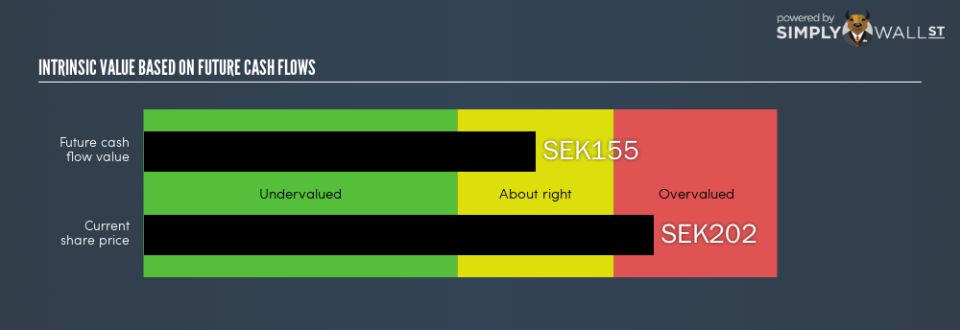Is Alfa Laval AB (publ) (STO:ALFA) Expensive For A Reason? A Look At The Intrinsic Value

Want to participate in a short research study? Help shape the future of investing tools and receive a $20 prize!
Today I will be providing a simple run through of a valuation method used to estimate the attractiveness of Alfa Laval AB (publ) (STO:ALFA) as an investment opportunity by taking the foreast future cash flows of the company and discounting them back to today’s value. I will use the Discounted Cash Flows (DCF) model. Don’t get put off by the jargon, the math behind it is actually quite straightforward. Anyone interested in learning a bit more about intrinsic value should have a read of the Simply Wall St analysis model. Please also note that this article was written in February 2019 so be sure check out the updated calculation by following the link below.
See our latest analysis for Alfa Laval
Step by step through the calculation
I use what is known as a 2-stage model, which simply means we have two different periods of varying growth rates for the company’s cash flows. Generally the first stage is higher growth, and the second stage is a more stable growth phase. To start off with we need to estimate the next five years of cash flows. For this I used the consensus of the analysts covering the stock, as you can see below. The sum of these cash flows is then discounted to today’s value.
5-year cash flow forecast
2019 | 2020 | 2021 | 2022 | 2023 | |
Levered FCF (SEK, Millions) | SEK4.83k | SEK5.56k | SEK5.75k | SEK5.93k | SEK6.12k |
Source | Analyst x9 | Analyst x9 | Analyst x3 | Est @ 3.21% | Est @ 3.21% |
Present Value Discounted @ 9.44% | SEK4.41k | SEK4.64k | SEK4.38k | SEK4.13k | SEK3.90k |
Present Value of 5-year Cash Flow (PVCF)= kr21b
We now need to calculate the Terminal Value, which accounts for all the future cash flows after the five years. The Gordon Growth formula is used to calculate Terminal Value at an annual growth rate equal to the 10-year government bond rate of 0.4%. We discount this to today’s value at a cost of equity of 9.4%.
Terminal Value (TV) = FCF2023 × (1 + g) ÷ (r – g) = kr6.1b × (1 + 0.4%) ÷ (9.4% – 0.4%) = kr68b
Present Value of Terminal Value (PVTV) = TV / (1 + r)5 = kr68b ÷ ( 1 + 9.4%)5 = kr43b
The total value, or equity value, is then the sum of the present value of the cash flows, which in this case is kr65b. In the final step we divide the equity value by the number of shares outstanding. If the stock is an depositary receipt (represents a specified number of shares in a foreign corporation) or ADR then we use the equivalent number. This results in an intrinsic value of SEK154.82. Compared to the current share price of SEK201.5, the stock is quite expensive and not available at a discount at this time.
The assumptions
I’d like to point out that the most important inputs to a discounted cash flow are the discount rate and of course the actual cash flows. You don’t have to agree with my inputs, I recommend redoing the calculations yourself and playing with them. Because we are looking at Alfa Laval as potential shareholders, the cost of equity is used as the discount rate, rather than the cost of capital (or weighed average cost of capital, WACC) which accounts for debt. In this calculation I’ve used 9.4%, which is based on a levered beta of 0.941. This is derived from the Bottom-Up Beta method based on comparable companies, with an imposed limit between 0.8 and 2.0, which is a reasonable range for a stable business.
Next Steps:
Whilst important, DCF calculation shouldn’t be the only metric you look at when researching a company. What is the reason for the share price to differ from the intrinsic value? For ALFA, there are three fundamental factors you should further research:
Financial Health: Does ALFA have a healthy balance sheet? Take a look at our free balance sheet analysis with six simple checks on key factors like leverage and risk.
Future Earnings: How does ALFA’s growth rate compare to its peers and the wider market? Dig deeper into the analyst consensus number for the upcoming years by interacting with our free analyst growth expectation chart.
Other High Quality Alternatives: Are there other high quality stocks you could be holding instead of ALFA? Explore our interactive list of high quality stocks to get an idea of what else is out there you may be missing!
PS. Simply Wall St does a DCF calculation for every SE stock every 6 hours, so if you want to find the intrinsic value of any other stock just search here.
We aim to bring you long-term focused research analysis driven by fundamental data. Note that our analysis may not factor in the latest price-sensitive company announcements or qualitative material.
If you spot an error that warrants correction, please contact the editor at editorial-team@simplywallst.com. This article by Simply Wall St is general in nature. It does not constitute a recommendation to buy or sell any stock, and does not take account of your objectives, or your financial situation. Simply Wall St has no position in the stocks mentioned. Thank you for reading.


